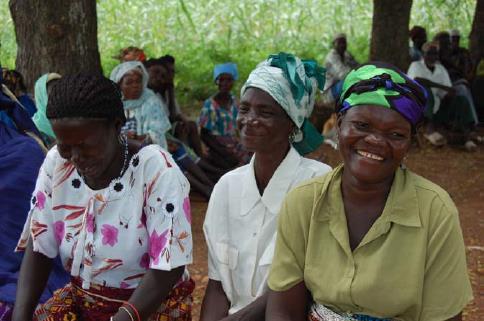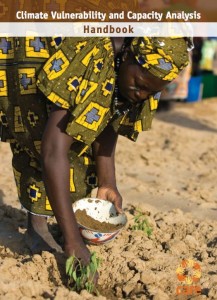Climate Vulnerability and Capacity Analysis Handbook
CARE developed the Climate Vulnerability and Capacity Analysis (CVCA) methodology and associated Handbook in 2009 to help development practitioners understand the implications of climate change within the context of poverty reduction and disaster risk reduction initiatives.

A group of women in Bansi Village in Bawku District in Northern Ghana enjoy a lighter moment during a participatory exercise. Photo © CARE/Angie Dazé
The main objectives of the CVCA are to analyze climate change vulnerability and adaptive capacity at the community level, and to combine community knowledge and scientific data to provide greater understanding about climate change impacts. The Handbook provides guidance on a methodology for gathering, organizing, and analyzing information on vulnerability and adaptive capacity of communities and of individuals and households within communities.
The Handbook was designed primarily for development practitioners and is intended to be applied at the beginning of a project cycle, so that the results can be used to support the design of adaptation projects or advocacy campaigns.
The Handbook provides a flexible and participatory process for the analysis, by providing a framework of guiding questions that explore the enabling factors for Community-Based Adaptation (CBA) at national, local, and household/individual levels. It includes a discussion of recommended tools including institutional mapping (to identify relevant institutions that may support or constrain adaptation efforts), key stakeholder interviews, and policy analysis.

CARE’s community-level tool that integrates climate change into a wider participatory vulnerability analysis.
Advantages of the CVCA Tool
- ability to directly support planning processes by providing context-specific information about the impacts of climate change, local vulnerability, and existing adaptive capacity
- can be used to support national- provincial, and community-level assessments
- provides guidance on how to create an enabling environment to support adaptation at local and national levels
- it is available in many different languages: English, Spanish, French, Portuguese, Bahasa Indonesia, and Thai
Limitations of the CVCA Tool
- does not provide specific guidance on how to incorporate future climate projections and other scientific information into community dialogues
- does not provide guidance on how to address uncertainties in climate and vulnerability data
- lack of guidance on how to analyze the information collected (e.g., gender inequality is recognized as a key underlying cause of vulnerability but the Handbook does not provide direction on how to undertake a gender analysis, despite the recommendation to collect gender- disaggregated data)
- does not offer detailed guidance on how to prioritize adaptation actions
Lessons Learned
- Experience with the tool has shown that users want and need more explicit guidance on data analysis in general, and specifically on gender analysis
- Important to consider the integration of a stronger ecosystems perspective on vulnerability and adaptive capacity
- Significant engagement with local stakeholders is required to gather information, analyze the data, validate the analysis, and for application in a broader participatory planning process. The length of time needed to apply the tool is variable based on project scope but has averaged around 6 months per site
